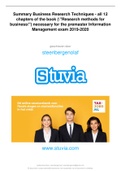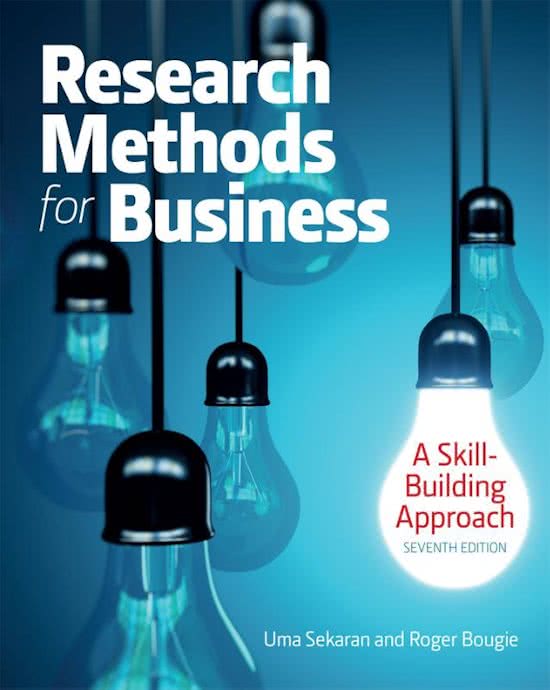Summary Business Research Techniques - all 12
chapters of the book (\"Research methods for
business\") necessary for the premaster Information
Management exam 2019-2020
geschreven door
steenbergenolaf
www.stuvia.com
Gedownload door: steenbergenolaf | steenbergenolaf@gmail.com
Dit document is auteursrechtelijk beschermd, het verspreiden van dit document is strafbaar.
, Stuvia - Koop en Verkoop de Beste Samenvattingen
Chapter 1: Introduction to research
Research is simply the process of finding solutions to a problem after a thorough study and analysis of the
situational factors. In some form or another, may help managers in organizations to make decisions at the
workplace. To be a successful manager it is important to know how to go about making the right decisions by
being knowledgeable about the various steps involved in finding solutions to problematic issues of interest to
the organization.
Business research is a systematic and organized effort to investigate a specific problem encountered in the
work setting, which needs a solution. This involves a series of steps, designed and executed with the goal of
finding answers to those issues. The first step is to know where the problem areas exist in the organization, and
to identify the problems that need to be studied and solved as specifically as possible. Once the problem is
clearly defined, steps can be taken to determine the factors that are associated with the problem, gather
information, analyze the data, develop an explanation and then solve it by taking the necessary corrective
measures. This entire process to attempt to solve problems is called research.
We can now define business research as an organized, systematic, data-based, critical, objective, inquiry or
investigation into a specific problem, undertaken with the purpose of finding answers or solutions to it.
Research provides the necessary information that guides managers to make informed decisions to successfully
deal with problems. Analyzed data can be primary data (gathered first hand) or secondary data (already
available in company, industry, archives) and can be quantitative or qualitative.
Some research is aimed at building theory, whereas other research is designed to test a theory or to describe
wat is going on, using an existing framework, instrument, or model. ‘Theory’ can mean a lot of things, but to a
scientist a theory explains a certain phenomenon, and the idea is that this explanation will hold in a wide range
of settings. A theory may thus vary in the extent to which it has been conceptually developed and empirically
tested. In business, research is usually primarily conducted to resolve problematic issues in, or interrelated
among, the areas of accounting, finance , management, and marketing. The issues within this subarea are
related to many factors within that particular system, they also need to be investigated in the context of the
external environment facing the business.
Research can be undertaken for 2 different purposes:
1. To solve a current problem faced by the manager in the work setting, demanding a timely solution =
applied research;
2. To generate a body of knowledge by trying to comprehend how certain problems that occur in
organizations can be solved = basic, fundamental, or pure research.
Basic, fundamental, or pure research is done chiefly to make a contribution to existing knowledge, that can
later be applied in organizational settings for problem solving. The primary purpose of this research is to
generate more knowledge and understanding of the phenomena of interest and to build theories based on
the research results. The process of building on existing knowledge is the genesis for theory building. Many
large companies also engage in basic research, for instance the study of online behavior and interactions to
gain insights into how social and technological forces interact. Both basic and applied research are carried out
in a scientific manner so that the results and findings can be relied upon to effectively solve the problem
investigated.
Managers with knowledge of research have an advantage over those without. Though you may not do major
research yourself, you will have to understand, predict, and control events that are dysfunctional for the
organization. Minor problems can be fixed by the manager, major problems warrant the hiring of outside
researchers or consultants. So it would help if managers could sense, spot, and deal with problems before they
get out of hand. Knowledge of research and problem-solving processes is important for this. When in need of
hiring outside researchers or consultants, the manager will also able to interact effectively with them.
Gedownload door: steenbergenolaf | steenbergenolaf@gmail.com
Dit document is auteursrechtelijk beschermd, het verspreiden van dit document is strafbaar.
, Stuvia - Koop en Verkoop de Beste Samenvattingen
Another advantage of knowing business research is to see the difference between the information
disseminated in business journals. Some journal articles are more scientific and objective than others, and even
among the scientific articles, some are more appropriate for application or adoption in the organization than
others.
Working with researchers-consultants, a manager needs to specify the roles (1) and to foresee what
information the researchers might require (2), and if those documents can be made available (3). They know
the possible constraints from the beginning, so they can start identifying alternate ways of tackling the
problem. Next to this, the manager needs to make sure there is congruence in the value systems of
management and consultants (4). Research knowledge will help managers to identify and explicitly state the
values that the organization holds clear, so there are no surprises down the road. This too gives the researchers
the opportunity to find alternative ways of dealing with the problems. At last, exchange of information in a
straightforward and forthright manner helps to increase the rapport and trust levels between two parties,
motivating both sides (5). Researchers will feel free to contact the manager for seek assistance.
There are 2 categories of consultants-researchers:
Internal consultants-researchers. Some organizations have their own consulting or research department,
serving as the internal consultant to subunits of the organization. This team will stand a better chance of being
readily accepted by the subunit, requires less time to understand the organization, are available to implement
the research findings and cost less than an external team. The disadvantage is that the internal consultants
may fall into a stereotyped way of looking at the organization and its problems, certain vested interest could
dominate, staff and management often don’t recognize them as “experts” and organizational biases of the
research team make the findings less objective.
External consultants-researchers. The external team has a wealth of experience from having worked with
different types of organizations and specific (related) problems and they have more knowledge of current
problem-solving models through their training programs. The major disadvantages are the costs of hiring them,
the time it takes to understand the business, and the charging of additional fees in the implementation of
research results.
If the problem is complex, or if there are likely to be vested interests, it would be advisable to engage external
researchers. On the other side, if problems are fairly simple, time is of the essence, or if there is a system-wide
need to establish procedures and policies of a fairly routine nature, the internal team is the better option. As a
manager, you make the final decision on the implementation of the recommendations by the research team.
Remaining objective, focusing on problem solutions, fully understanding the recommendations made, and why
and how they have been arrived at, make for good managerial decision making.
Ethics in business research refers to a code of conduct or expected societal norms of behavior while
conducting research. This applies to the organization and members that sponsor the research, the researchers
themselves, and the respondents who provide them with the necessary data. Ethical behavior pervades each
step of the research process, determining how the subjects are treated.
Gedownload door: steenbergenolaf | steenbergenolaf@gmail.com
Dit document is auteursrechtelijk beschermd, het verspreiden van dit document is strafbaar.
, Stuvia - Koop en Verkoop de Beste Samenvattingen
Chapter 2: The scientific approach and alternative approaches to investigation
Scientific research focuses on solving problems and pursues a step-by-step logical, organized, and rigorous
method to identify problems, gather data, analyze them, and draw valid conclusions from them. Thus, research
is not based on hunches, experience, and intuition. So scientific investigation tends to be more objective,
helping managers to highlight the most critical factors at the workplace.
Researchers do not always take a scientific approach to research: they might have a different perspective om
what makes good research, the problem might be too simple, or past experience might offer the solution.
Finally, exigencies of time, unwillingness to expend the right resources needed, lack of knowledge, and other
factors might prompt businesses to solve problems based on hunches. The hallmarks (main distinguishing
characteristics) of scientific research are:
- Purposiveness, starting with a definite aim or focus (a purposive focus).
- Rigor, connoting carefulness, scrupulousness, and the degree of exactitude in research investigations.
Conclusions from an investigation need to have a theoretical foundation and methodological
sophistication.
- Testability, applying to the hypotheses of a study. Hypothesis need to be testable to be able to test
whether or not support them with data.
Hypothesis: a tentative, yet testable, statement, which predicts what you expect to find in your empirical data.
This is derived from theory, which is based on the logical beliefs of the researchers and on previous scientific
research.
- Replicability, causing the results of the tests or hypotheses to be supported again and yet again when
the same type or research is repeated in similar circumstances.
Replication is made possible by a detailed description of the design details of the study (sampling method, data
collection method), creating the possibility to replace the research.
- Precision and confidence, designing the research in a manner that we can place reliance or confidence
in the results. We can’t draw definitive conclusions and study the universe of items or population.
Precision refers to the closeness of the findings to ‘reality’ based on a sample. Reflecting on the degree of
accuracy or exactitude of the results on the basis of the sample, to what really exists in the universe. The
confidence interval (in statistics) can be recalled, here called precision. Confidence refers to the probability that
our estimations are correct. You need to confidently claim that 95% of the time our results will be true and
there is only a 5% chance of our being wrong. This is also called confidence level.
- Objectivity, the conclusions drawn through interpretation of the results of data analysis should be
objective: based on the facts of the findings derived from actual data, and not our own (subjective or
emotional) values.
Although managers or researchers might start with some initial subjective values and beliefs, their
interpretation of the data should be stripped of personal values and bias.
- Generalizability, referring to the scope of applicability of the research findings in one organizational
setting to other settings. The wider the range of applicability, the more useful it is to the users.
For wider generalizability, the research sampling design has to be logically developed and details in the data-
collection methods need to be meticulously followed. However, such sampling designs would also increase the
costs of research. Limited applicability does not decrease scientific value, its generalizability is just restricted.
- Parsimony, creating a good understanding of the problem and the important factors that influence it.
If 3 variables are found in the work situation to raise employee-commitment with 45%, that would be more
useful than calling 11 variables that could raise that by 49%. A lesser number of variables built in the research
framework can explain the variance far more efficiently than a complex set of variables.
Gedownload door: steenbergenolaf | steenbergenolaf@gmail.com
Dit document is auteursrechtelijk beschermd, het verspreiden van dit document is strafbaar.





